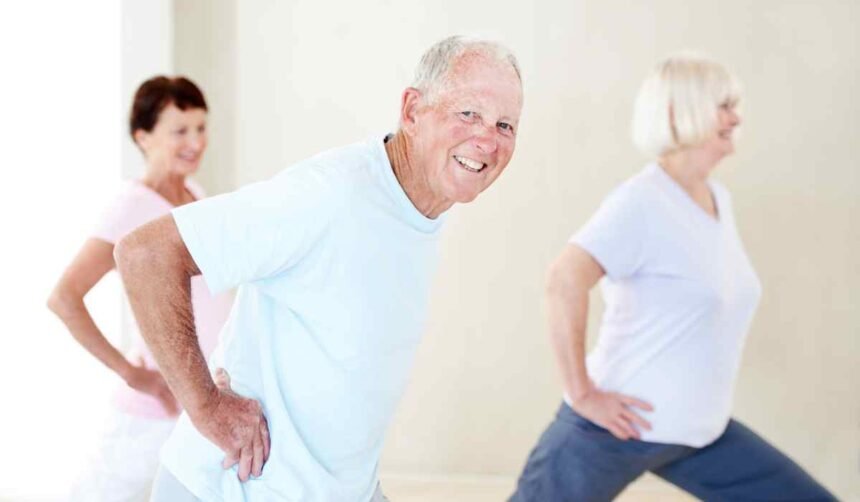As we get older, our bodies naturally become less flexible. Joints stiffen, muscles tighten, and it becomes harder to bend, stretch, and move freely. Lack of flexibility can make everyday activities more difficult and increase the risk of injuries.
The good news is that you can take steps to maintain and improve flexibility at any age. Here are some effective and easy ways to stay limber as you get older:
Stretch Regularly
Stretching is one of the best ways to preserve and enhance flexibility.Aim to stretch all major muscle groups such as the calves, thighs, hips, back, chest, shoulders, and neck. Try to stretch at least 3-5 days per week for at least 10-30 minutes per session. Make sure to warm up first by walking or doing light aerobic activity to get the blood flowing.
Move slowly into each stretch, holding for at least 30 seconds. Feel the stretch but don’t push to the point of pain. Breathe deeply and relax into the stretch. Yoga, Pilates, and tai chi are great full-body stretching routines.
Get Regular Massages
Massage therapy helps relax tight muscles, increase blood flow, and improve range of motion. Schedule regular massages monthly or even weekly if you can. Massage therapists can target problem areas and work out knots. Self-massage is also helpful. Use a foam roller, tennis ball, or massage stick to roll out tight spots. Focus on areas that feel tender for a few minutes at a time until they release.
Try Assisted Stretching
Using assistance from straps, blocks, chairs or a partner makes it easier to move deeper into a stretch safely. For example, lying on your back with a strap around the arch of your foot helps extend a hamstring stretch. Holding onto a chair while bending one knee back creates a great quad stretch. Having someone provide gentle pressure can also help you go further.
Strengthen Your Muscles
Building muscle strength protects joints and supports flexibility. Focus on major muscle groups like the core, back, shoulders, legs and glutes. Use bodyweight, resistance bands, free weights or weight machines. Aim for 2-3 strength sessions per week of 30-45 minutes each. Allow at least one rest day between sessions for muscles to recover.
Try Foam Rolling
Using a foam roller applies pressure to loosen tissues and trigger points. Slowly roll back and forth over tight spots for 30-90 seconds until you feel the tension release. Focus on areas like the lower back, IT band, hamstrings, calves and shoulders. Foam rolling improves circulation and reduces muscle stiffness.
Add Omega-3 Fatty Acids
Omega-3s provide anti-inflammatory benefits to improve joint health. Fatty fish like salmon and tuna are high in omega-3s. You can also take fish oil supplements or use ground flaxseeds. Aim for at least 250-500 mg daily. This can help ease stiffness and pain.
Manage Your Weight
Excess weight puts more pressure on your joints and spine, making flexibility harder. Try to maintain a healthy weight through diet and exercise. Losing even just 10 lbs can improve mobility if overweight. Focus on anti-inflammatory whole foods like fruits, vegetables, lentils, nuts and healthy fats. Stay active with daily walks plus strength training.
Practice Tai Chi and Qigong
Tai chi and qigong combine gentle movements, deep breathing and mental focus. The flowing poses increase strength and flexibility through the full range of motion. Regular practice reduces stiffness and back pain. It also helps with balance, circulation and mood. Take a class or follow video instructions.
Try Dynamic Stretching
Dynamic stretches gently move joints and muscles through controlled motions. For example, swinging your arms across your body, lunges with a twist, leg swings, torso twists, etc. Do 8-10 reps of dynamic moves to warm up before exercise or stretching. This mobilizes the joints and reduces risk of injury.
Drink More Water
Staying hydrated keeps your joints, tendons, ligaments and muscles more supple. Dehydration causes tightness and strain. Aim to drink at least 6-8 glasses of fluid daily. Avoid diuretics like caffeine and alcohol which can dehydrate. Eating foods with high water content like cucumbers, oranges and watermelon also helps.
Take Warm Baths
Warm water helps relax muscles and increase blood flow. Add Epsom salts to absorb into sore spots. You can stretch more easily after a warm bath since your muscles and joints are looser. Aim for 15-20 minute soaks a few times per week, especially after exercise.
Supplement With Collagen
Collagen is the main structural protein in connective tissues like tendons, ligaments and cartilage. Our natural collagen production declines with age. Consider a hydrolyzed collagen supplement with added vitamin C to help build and maintain flexibility. 10-15g daily can improve joint mobility.
Get Adjusted
Seeing a chiropractor can improve spinal alignment and posture, enhancing range of motion. A chiropractor uses techniques like spinal manipulation to improve joint function. Massage therapists can also help align the body. Get adjusted regularly, such as monthly, for optimal benefits.
Use Topical Analgesics
Creams, gels, sprays, patches and roll-ons can ease muscle and joint aches from the outside. Products containing menthol, camphor, capsaicin, turmeric, arnica and CBD provide temporary relief so you can move with less discomfort. Apply as needed to problem areas.
Try Acupuncture
Acupuncture uses very fine needles applied to specific points to reduce pain and increase circulation. Research shows it effective for reducing arthritis symptoms and improving mobility. The minor stimulation helps loosen stiff tissues. Schedule treatments weekly or monthly depending on your needs.
Improve Your Posture
Poor posture causes stiffness, especially in the upper back. Improve how you sit, stand and move to take pressure off your joints and spine. Look in the mirror and bring your shoulders back, pull in your stomach, tuck your pelvis and align your head. Use posture reminders like wall stickers.
Stay Active
Keep moving to maintain flexibility. Low-impact activities like walking, swimming, cycling, yoga and Pilates keep joints mobile. Make sure to build up your duration and intensity slowly. Take frequent breaks and rest days. Listen to your body. Any movement is beneficial, so find activities you enjoy.
Conclusion
In conclusion, scheduling regular stretching, massages and strength training are effective ways to support flexibility as you get older. Focus on full-body movements through tai chi, yoga and other modalities. Stay hydrated, manage your weight and be mindful of posture and ergonomics.
See a chiropractor or try supplements if needed. The most important thing is to keep moving safely every day. Small steps to stay limber now will help you maintain an active lifestyle for years to come.
- Mayo Clinic – Stretching: Focus on flexibility https://www.mayoclinic.org/healthy-lifestyle/fitness/in-depth/stretching/art-20047931
- ACE Fitness – Dynamic Stretching vs. Static Stretching https://www.acefitness.org/education-and-resources/professional/expert-articles/5008/dynamic-stretching-vs-static-stretching/
- Healthline – 10 Natural Ways to Build Healthy Bones https://www.healthline.com/nutrition/10-nutrients-for-healthy-bones#TOC_TITLE_HDR_2












